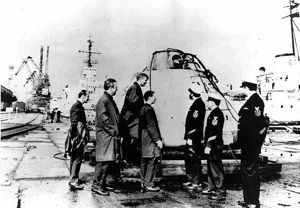
It was a beautiful morning in Houston, with a few days remaining of our Professional Development Conference at NASA's Johnson Space Center. We aerospace educators met annually at a NASA center to get up to date on the latest NASA education and science programs. The night before, we watched the movie
Apollo 13 from the original mission control room, the film being projected on the same screen that displayed the televised images from the moon. When it was my turn to watch from the Flight Director's chair, I stood behind and paced - we never saw Gene Krantz sitting down. Earlier that day, I crossed the street to the municipal complex where a refreshed Apollo boilerplate BP-K had been placed on display. But now, a new day to hear from NASA on how to inspire today's youth.
We were meeting at the Gilruth Center, a multi-purpose facility for JSC employees. Noshing on pastries and morning caffeine, we were slowly making our way to our meeting room. Suddenly, someone came in saying, "Return to your duty stations. Return to your duty stations, now!" Someone said we were from across the country and had no duty at JSC, so we were sent to the meeting room where we were going anyway. Wondering why, we were told that something had happened in New York City, so we turned on the TV projector and saw smoke billowing from the World Trade Center. We watched a little, then tried to start our session while we monitored the video.
When the second plane hit we knew that there was something very serious in the works. The JSC guy who told us to get to our duty stations returned to say that JSC was closing down - planes were being grounded and fear that some were heading toward Washington. Or boss took the podium and offered a choice; remain in Houston until flights resumed or take our rentals and drive home. A call to the rental agency confirmed we could do this (with the appropriate rate increases), so we decided to drive home. Within an hour we were checked out of the hotel, with four of us heading east on I-10. Listening to the radio, we pieced together what had happened and discussed how the world was changed. One colleague remarked, "Look at the sky. Not a contrail in sight. We've never seen a sky without airplanes."
Stay tuned for the rest of this story.
 This Saturday will be the last for the Visitor Center at the Glenn Research Center in Cleveland Ohio. Due to budget cuts, the VC will close and move to the Great Lakes Science Museum downtown. The VC is currently home for the Skylab 2 Apollo capsule, displayed in a small rotunda on a rotating base. It is assumed the spacecraft will follow the VC to Great Lakes, but the decision is up to the Smithsonian. There are a lot of newer air and space museums that would love to display a flown manned spacecraft.
This Saturday will be the last for the Visitor Center at the Glenn Research Center in Cleveland Ohio. Due to budget cuts, the VC will close and move to the Great Lakes Science Museum downtown. The VC is currently home for the Skylab 2 Apollo capsule, displayed in a small rotunda on a rotating base. It is assumed the spacecraft will follow the VC to Great Lakes, but the decision is up to the Smithsonian. There are a lot of newer air and space museums that would love to display a flown manned spacecraft. 



 d visited Murmansk as a port of call during a six month arctic survey. They were surprised when, with a considerable amount of hoopla, they were presented with the Apollo capsule.
d visited Murmansk as a port of call during a six month arctic survey. They were surprised when, with a considerable amount of hoopla, they were presented with the Apollo capsule. 
